Research on Green Modular Disaster Prevention Product Design and Spatial Configuration Strategy Based on AHP-GIS
Abstract
1. Introduction
2. Literature Review
2.1. Hazards of Natural Disasters
2.2. Current Status of Disaster Prevention Product Development
- (1)
- (2)
- Humanization and personalization: Based on the user’s physical and mental experience, post-disaster product design should meet specific environmental integration and visual aesthetic needs [10] and be dedicated to providing a “human-centered” humane recreation experience.
- (3)
- Ease of operation and maintenance difficulty: Most disaster prevention products have a complex operation process and must be more convenient. Maintaining and cleaning the products is also problematic, requiring professional staff to handle and replace them [11].
- (4)
- Traditional form and single function: Many existing disaster prevention products are only for a particular natural disaster or an emergency scenario, cannot meet comprehensive disaster prevention needs, and require more innovation [12].
- (5)
- Comfort and ergonomics: When responding to natural disasters, the comfort and ergonomics of equipment are crucial [13].
2.3. Current Status of Green Modular Product Design Research
3. Research Methodology
3.1. Geographic Information System
3.1.1. Overview of Geographic Information System Method
3.1.2. Disaster Prevention Geographic Information System
- (1)
- Mapping locations: GIS enables the identification and mapping of specific places. GIS facilitates the creation of maps by employing automated mapping techniques, data collection, and analytical tools.
- (2)
- Mapping quantities: To fulfill particular requirements or comprehend relationships between locations, individuals map quantitative aspects, such as identifying areas with the highest and lowest quantities. This approach provides more comprehensive insights than solely mapping feature locations.
- (3)
- Mapping densities: In areas with multiple features, merely mapping the feature locations may not effectively reveal variations in concentration. Through density mapping, one can employ a consistent areal unit, such as acres or square miles, to quantify the number of features and visualize their distribution.
- (4)
- Finding distances: GIS enables the exploration of activities occurring within a specific radius of a feature.

3.2. Analytic Hierarchy Process
3.2.1. Overview of Analytic Hierarchy Process Method
3.2.2. Green Modular Analytic Hierarchy Process
3.3. Research Step Analysis
- (1)
- Collection of spatial data: Spatial data, including water system distribution, flood-affected locations, and population density in the GBA, are collected and imported into the geographic information system to generate digital visual maps.
- (2)
- Identification of highly affected urban areas: Through the analysis of the visual maps, the urban areas within GBA megacities that are most vulnerable to flooding are identified. Based on the natural geography of these areas, a spatial configuration strategy for disaster prevention products is formulated.
- (3)
- User needs exploration: Quantitative and qualitative research is conducted on the target groups, involving user interviews and questionnaires. The research aims to understand the requirements and expectations of flood refugees in Zhuhai in terms of the products’ post-disaster recovery and reconstruction functionalities.
- (4)
- In-depth analysis of research results: The research findings are thoroughly examined to uncover the target group’s implicit needs and underlying motivations. This analysis helps to refine and translate the identified needs into specific design requirements.
- (5)
- Qualitative analysis of design requirements: User requirements are further classified and summarized, leading to a qualitative analysis of design requirements. Design elements and directions are determined based on this analysis.
- (6)
- Hierarchical modeling and quantification: The hierarchical analysis method transforms user requirements into a recursive hierarchical structure model. The design elements are quantified using appropriate mathematical methods, clarifying the design objectives.
- (7)
- Weight determination and analysis: The total weight values of all design elements are computed and sorted. Each design element is thoroughly analyzed and understood, leading to the selection of the most appropriate design solution.
- (8)
- Numerical simulation and professional evaluation: In the objective quantitative aspect, numerical simulations are conducted to examine the mechanical performance of EDPIC in earthquake-prone regions. In the subjective qualitative aspect, the scientific validity of the solution is verified through expert scoring and user feedback evaluation after using the product.

4. Research Process and Data Analysis
4.1. Natural Geography Data Analysis
4.1.1. Data Analysis Based on GIS
- (1)
- Water system distribution
- (2)
- Population density
- (3)
- Flood-affected areas
4.1.2. Study Area and Spatial Configuration Strategy Development
4.2. User Research and Needs Analysis
4.2.1. Preliminary Research
4.2.2. User Interview
4.2.3. Analysis of Research Results
4.2.4. Summary of Recognition of Green Modular Concept and Product Design Elements
- (1)
- Water and moisture resistance: Given the damp environment following a flood, the product must effectively safeguard property and health by protecting against water and moisture.
- (2)
- Safety and stability: The product should exhibit sufficient stability and durability to withstand the potential damage and risks associated with flooding.
- (3)
- Rapid deployment: The ability to swiftly erect and dismantle the products is critical, enabling refugees to adapt to rapidly changing environments and cater to their evolving needs.
- (4)
- Spatial flexibility: The product should offer ample space and flexibility to accommodate the diverse requirements of refugee families and individuals.
- (5)
- Human comfort: The products must create a comfortable, warm, safe, and hygienic environment, prioritizing the physical and psychological well-being of the refugees.
- (6)
- Sustainability: Environmental impact and sustainability considerations are paramount. The products should utilize environmentally friendly materials and energy sources while minimizing waste and pollution.
- (7)
- Ease of transportation and storage: Products should be easily transportable and storable, facilitating rapid deployment and disassembly when needed.
4.3. Primary and Secondary Analysis of Combination of Modular Design Elements and User Needs
4.3.1. Calculation of Design Evaluation Level Index Weights
4.3.2. Analysis of Design Elements
4.4. Green Module-Based Disaster Prevention Design Practice for Flood Refugees in Zhuhai
4.4.1. Sustainability
4.4.2. Operational Practicality
4.4.3. Flexibility and Richness of Form
4.4.4. Safety and Comfort
4.4.5. Aesthetic Ornamental Aspects
4.4.6. Summary of Design
4.5. Design Evaluation Processes
4.5.1. Expert Panel
- (1)
- Functionality: The extent to which the product performs its intended function effectively.
- (2)
- Usability: The ease of use and user-friendliness of the product.
- (3)
- Durability: The product’s ability to withstand environmental conditions and wear over time.
- (4)
- Safety: The degree to which the product ensures the safety of its users.
- (5)
- Aesthetics: The visual appeal and design quality of the product.
- (6)
- Sustainability: The environmental impact and use of sustainable materials in the product’s design.
- (7)
- Cost-effectiveness: The balance between the product’s cost and its overall value and performance.
4.5.2. User Ratings
5. Discussion
5.1. Analysis of Application Scenarios and Engineering Mechanical Characteristics
5.2. Strategies for Disaster Prevention Products and Management at Multiple Levels
5.3. Limitations
6. Conclusions
- (1)
- A case study on post-disaster product design for flood refugees in Zhuhai was conducted. Utilizing GIS technology, the most affected areas were identified, leading to the development of a targeted spatial configuration strategy based on natural geography. This approach improved product efficacy and resulted in a more comprehensive overall strategy.
- (2)
- By prioritizing user demands, the study applied the AHP method to quantify requirements and prioritize user needs, directly translating these into design recommendations. This explicit connection between user research findings and final product design ensured enhanced design efficiency and user satisfaction, with the product’s effectiveness verified. The research methodology and process, based on addressing natural disaster issues in the Greater Bay Area and utilizing the GIS-AHP analysis method, provide valuable insights for similar product research endeavors.
- (3)
- Numerical simulations evaluated the protective efficacy of the EDPIC under debris flow impact conditions. As the distance between the EDPIC and the slope angle (SPIC) increased from 30 to 150 m, the maximum impact force significantly decreased, while the average impact force diminished by approximately two orders of magnitude. This analysis resulted in an empirical formula that can serve as a valuable reference for engineering design purposes.
- (4)
- This study presents a novel and integrated approach to designing post-disaster emergency products, combining GIS, AHP, and numerical simulations. Key findings include the identification of effective spatial strategies for product placement, improved design efficiency and user satisfaction through the AHP method, and the validation of product efficacy under diverse conditions. The AHP approach was crucial in quantifying requirements and prioritizing user needs, ensuring a clear connection between user research findings and final product design.
- (5)
- A significant contribution of this study is the development of a comprehensive disaster prevention product strategy by integrating macro, meso, and micro research levels into a unified model. At the macro level, GIS analysis helps identify and prioritize areas most in need of disaster prevention products. At the meso level, the AHP method is used to systematically evaluate and prioritize user needs and design features. At the micro level, numerical simulations provide detailed insights into the material properties and structural performance under various disaster scenarios. This multi-layered approach ensures that the design process is both thorough and adaptable, addressing the complex nature of disaster prevention comprehensively. This holistic approach, which combines spatial analysis, user-centered design, and technical validation, has not been proposed in previous studies on disaster prevention products. By integrating these research levels, the study not only enhances the effectiveness and relevance of the products but also sets a new standard for future research in this field.
Author Contributions
Funding
Data Availability Statement
Conflicts of Interest
Nomenclature
| AHP | Analytic hierarchy process |
| GIS | Geographic information system |
| GBA | Greater Bay Area |
| FEMA | Federal Emergency Management Agency |
| PRD | Pearl River Delta |
| PTFE | Polytetrafluoroethylene |
| EDPIC | Emergency disaster prevention inflatable cabin |
| HPIC | The vertical height of the center of mass of the prevention inflatable cabin from the ground |
| SPIC | The horizontal distance between the prevention inflatable cabin and the foot of the slope |
References
- Wang, W.; Wu, T.; Li, Y.; Xie, S.; Han, B.; Zheng, H.; Ouyang, Z. Urbanization Impacts on Natural Habitat and Ecosystem Services in the Guangdong-Hong Kong-Macao “Megacity”. Sustainability 2020, 12, 6675. [Google Scholar] [CrossRef]
- Blaikie, P.; Cannon, T.; Davis, I.; Wisner, B. At Risk: Natural Hazards, People’s Vulnerability and Disasters; Routledge: London, UK, 2014. [Google Scholar]
- Yin, H.; Li, C. Human impact on floods and flood disasters on the Yangtze River. Geomorphology 2001, 41, 105–109. [Google Scholar] [CrossRef]
- Lăzăroiu, G.; Ionescu, L.; Uță, C.; Hurloiu, I.; Andronie, M.; Dijmărescu, I. Environmentally responsible behavior and sustainability policy adoption in green public procurement. Sustainability 2020, 12, 2110. [Google Scholar] [CrossRef]
- Bhosekar, A.; Ierapetritou, M. Modular design optimization using machine learning-based flexibility analysis. J. Process Control. 2020, 90, 18–34. [Google Scholar] [CrossRef]
- Shrestha, B.; Uprety, S.; Pokharel, J.R. Residential Satisfaction of post-disaster resettled communities: A Case of Thakle Integrated Settlement. In Proceedings of the 11th IOE Graduate Conference, Pokhara, Nepal, 10–11 March 2022. [Google Scholar]
- Safapour, E.; Kermanshachi, S.; Pamidimukkala, A. Post-disaster recovery in urban and rural communities: Challenges and strategies. Int. J. Disaster Risk Reduct. 2021, 64, 102535. [Google Scholar] [CrossRef]
- Gao, X.; Pishdad-Bozorgi, P. BIM-enabled facilities operation and maintenance: A review. Adv. Eng. Inform. 2019, 39, 227–247. [Google Scholar] [CrossRef]
- Yu, D.; He, Z. Digital twin-driven intelligence disaster prevention and mitigation for infrastructure: Advances, challenges, and opportunities. Nat. Hazards 2022, 112, 1–36. [Google Scholar] [CrossRef]
- Gumasing, M.J.J.; Prasetyo, Y.T.; Ong, A.K.S.; Nadlifatin, R.; Persada, S.F. Determining Factors Affecting the Perceived Preparedness of Super Typhoon: Three Broad Domains of Ergonomics Approach. Sustainability 2022, 14, 12202. [Google Scholar] [CrossRef]
- Fei, W.; Lu, D.; Li, Z. Research on the layout of urban disaster-prevention and risk-avoidance green space under the improvement of supply and demand match: The case study of the main urban area of Nanjing, China. Ecol. Indic. 2023, 154, 110657. [Google Scholar] [CrossRef]
- Gao, H.; Zhang, Y. Application of Modular Design Method in Product Design. In Proceedings of the 2020 International Conference on Intelligent Design (ICID), Xi’an, China, 11–13 December 2020; pp. 292–297. [Google Scholar]
- Ko, Y.T. Modeling an innovative green design method for sustainable products. Sustainability 2020, 12, 3351. [Google Scholar] [CrossRef]
- Ghannad, P.; Lee, Y.C.; Choi, J.O. Feasibility and implications of the modular construction approach for rapid post-disaster recovery. Int. J. Ind. Constr. 2020, 1, 64–75. [Google Scholar] [CrossRef]
- Zhao, L.; Li, H.; Sun, Y.; Huang, R.; Hu, Q.; Wang, J.; Gao, F. Planning emergency shelters for urban disaster resilience: An integrated location-allocation modeling approach. Sustainability 2017, 9, 2098. [Google Scholar] [CrossRef]
- Zhang, C.; Xu, T.; Wang, T.; Zhao, Y. Spatial-temporal evolution of influencing mechanism of urban flooding in the Guangdong Hong Kong Macao greater bay area, China. Front. Earth Sci. 2023, 10, 1113997. [Google Scholar] [CrossRef]
- Sylves, R.T. Federal emergency management comes of age: 1979–2001. In Emergency Management; Routledge: London, UK, 2019; pp. 113–165. [Google Scholar]
- Makwana, N. Disaster and its impact on mental health: A narrative review. J. Fam. Med. Prim. Care 2019, 8, 3090. [Google Scholar] [CrossRef]
- Shah, A.A.; Gong, Z.; Pal, I.; Sun, R.; Ullah, W.; Wani, G.F. Disaster risk management insight on school emergency preparedness—A case study of Khyber Pakhtunkhwa, Pakistan. Int. J. Disaster Risk Reduct. 2020, 51, 101805. [Google Scholar] [CrossRef]
- Rouhanizadeh, B.; Kermanshachi, S.; Nipa, T.J. Exploratory analysis of barriers to effective post-disaster recovery. Int. J. Disaster Risk Reduct. 2020, 50, 101735. [Google Scholar] [CrossRef]
- Smith, S.; Yen, C.C. Green product design through product modularization using atomic theory. Robot. Comput.-Integr. Manuf. 2010, 26, 790–798. [Google Scholar] [CrossRef]
- Inoue, M.; Yamada, S.; Miyajima, S.; Ishii, K.; Hasebe, R.; Aoyama, K.; Bracke, S. A modular design strategy considering sustainability and supplier selection. J. Adv. Mech. Des. Syst. Manuf. 2020, 14, JAMDSM0023. [Google Scholar] [CrossRef]
- Ampah, J.D.; Jin, C.; Fattah, I.M.R.; Appiah-Otoo, I.; Afrane, S.; Geng, Z.; Liu, H. Investigating the evolutionary trends and key enablers of hydrogen production technologies: A patent-life cycle and econometric analysis. Int. J. Hydrogen Energy 2022, 48, 37674–37707. [Google Scholar] [CrossRef]
- Nocera, F.; Castagneto, F.; Gagliano, A. Passive house as temporary housing after disasters. Renew. Energy Power Qual. J. 2020, 18, 42–47. [Google Scholar] [CrossRef]
- Su, C.; Yuan, Z. Research on Design of Extensible Mobile Flood Control Wall in Underground. Math. Probl. Eng. 2022, 2022, 1–7. [Google Scholar] [CrossRef]
- Herath, H.M.R.G.; Jayasundara, K.K.W.S.P.K.; Yadhasighe, Y.K.A.; Sanjeewa, S.D. The design and implementation of an IOT-based real-time air purification system for outdoor environment. In Proceedings of the 2022 2nd International Conference on Advanced Research in Computing (ICARC), Belihuloya, Sri Lanka, 23–24 February 2022; pp. 314–319. [Google Scholar]
- Marques, P.; Manfroi, D.; Deitos, E.; Cegoni, J.; Castilhos, R.; Rochol, J.; Kunst, R. An IoT-based smart cities infrastructure architecture applied to a waste management scenario. Ad Hoc Netw. 2019, 87, 200–208. [Google Scholar] [CrossRef]
- Khan, Z.; Ips, P.H. Building Resilient Smart Cities: Sustainability and Inclusiveness. In Proceedings of the Fifth World Congress on Disaster Management: Volume V: Proceedings of the International Conference on Disaster Management, New Delhi, India, 24–27 November 2021; Taylor & Francis: Abingdon, UK, 2023. [Google Scholar]
- Escobar, F.; Hunter, G.; Bishop, I.; Zerger, A. Introduction to GIS; Department of Geomatics, The University of Melbourne: Parkville, Australia, 2008. [Google Scholar]
- Jin, Y.; Xu, J.; Liu, Z. Research on aging design principle of smart kitchen products based on CHC-AHP. Furnit. Inter. Decor. 2022, 29, 42–48. [Google Scholar]
- Wu, X.D.; Kumar, V.; Quinlan, J.R.; Ghosh, J.; Yang, Q.; Motoda, H.; McLachlan, G.J.; Ng, A.; Liu, B.; Yu, P.S.; et al. Top 10 algorithms in data mining. Knowl. Inf. Syst. 2008, 14, 1–37. [Google Scholar] [CrossRef]
- Ning, J.; National Bureau of Statistics. The Main Data of the Seventh National Census; National Bureau of Statistics: Beijing, China, 2020.
- Bi, Y.Z.; Du, Y.J.; He, S.M.; Sun, X.; Wang, D.; Li, X.; Wu, Y. Numerical analysis of effect of baffle configuration on impact force exerted from rock avalanches. Landslides 2018, 15, 1029–1043. [Google Scholar] [CrossRef]
- Bi, Y.; He, S.; Du, Y.; Shan, J.; Yan, S.X.; Wang, D.P.; Sun, X.P. Numerical investigation of effects of “baffles-deceleration strip” hybrid system on rock avalanches. J. Mt. Sci. 2019, 16, 414–427. [Google Scholar] [CrossRef]
- Zhou, G.G.D.; Ng, C.W.W. Numerical investigation of reverse segregation in debris flows by DEM. Granul. Matter 2010, 12, 507–516. [Google Scholar] [CrossRef]




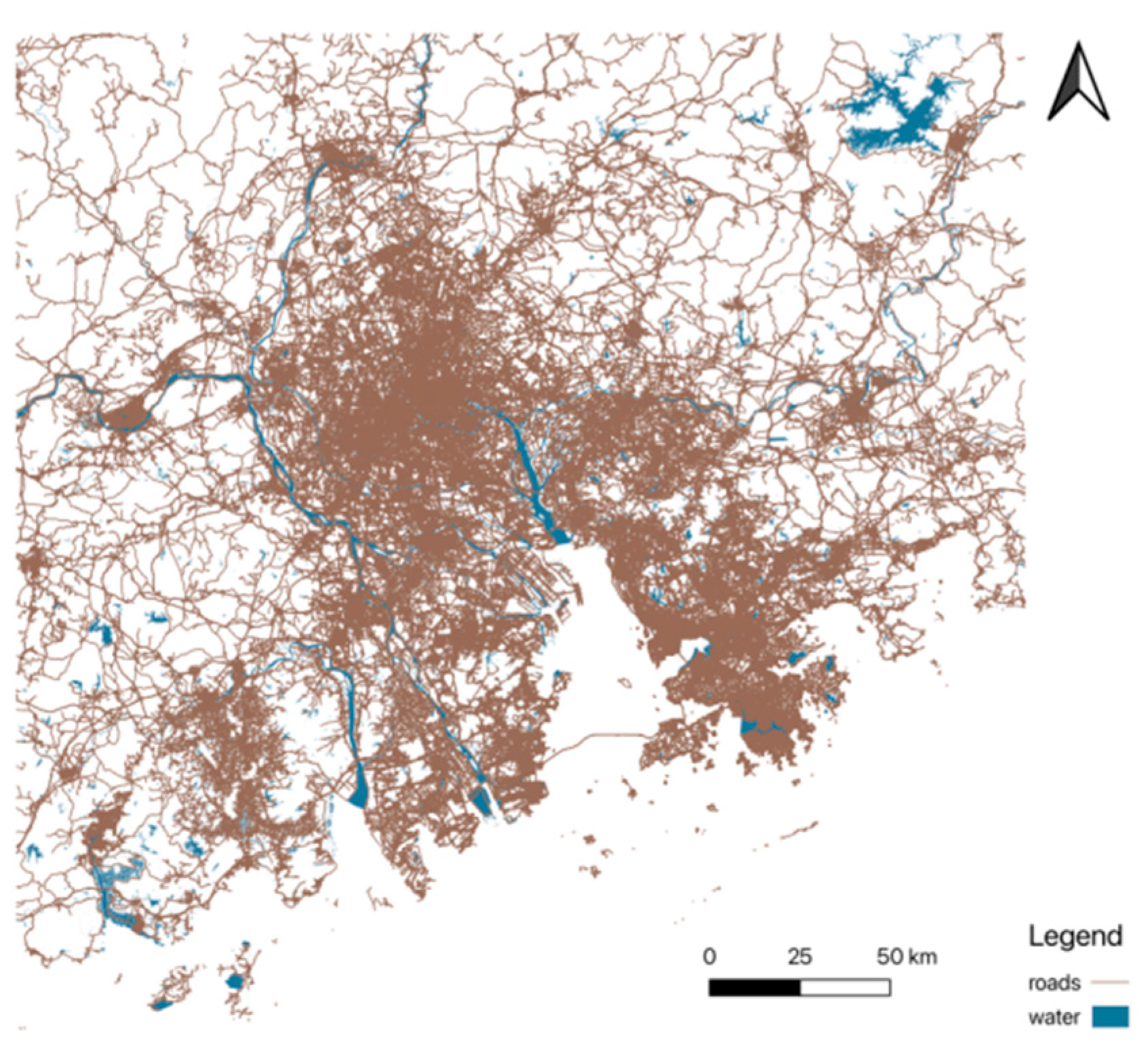
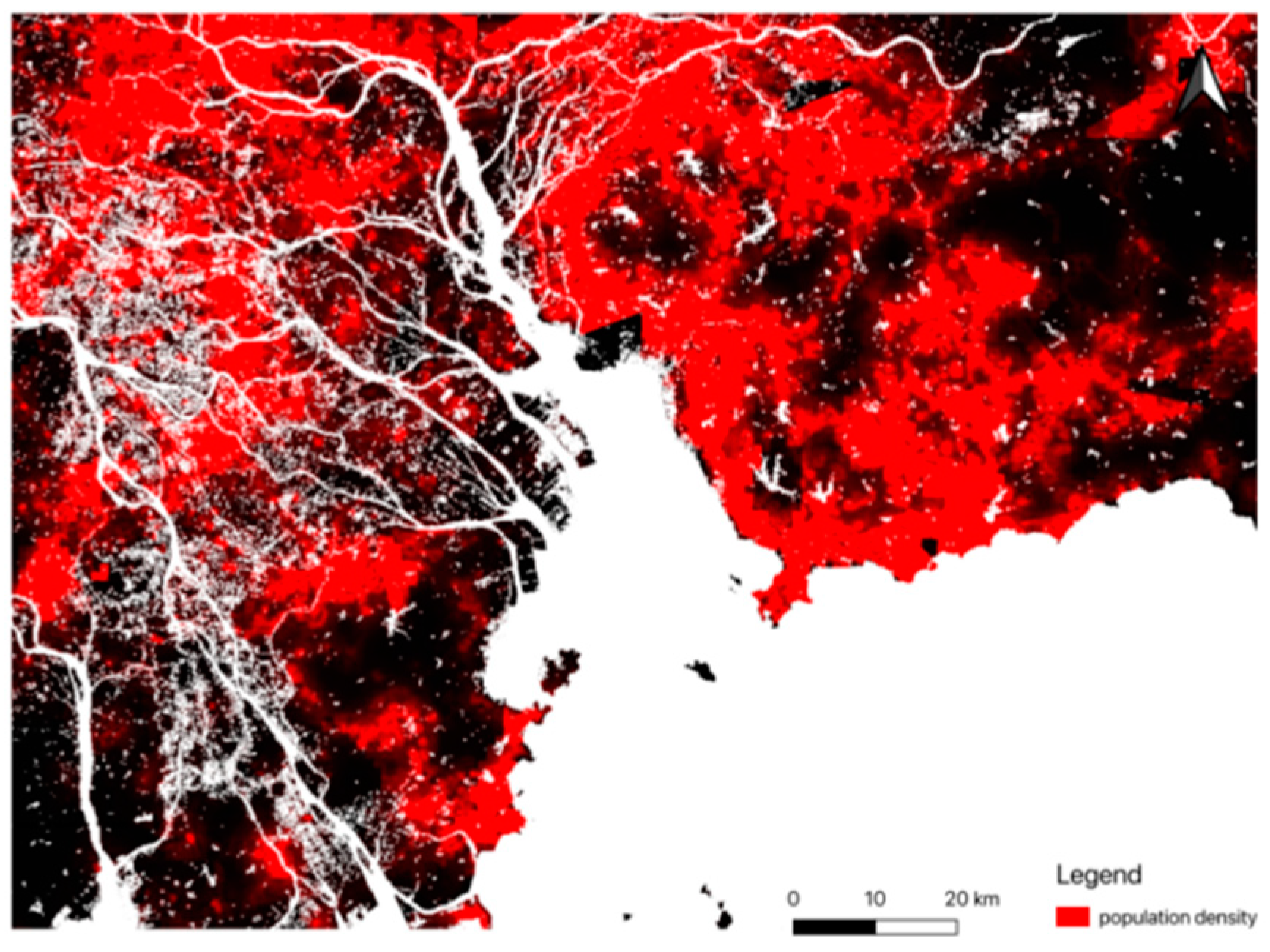



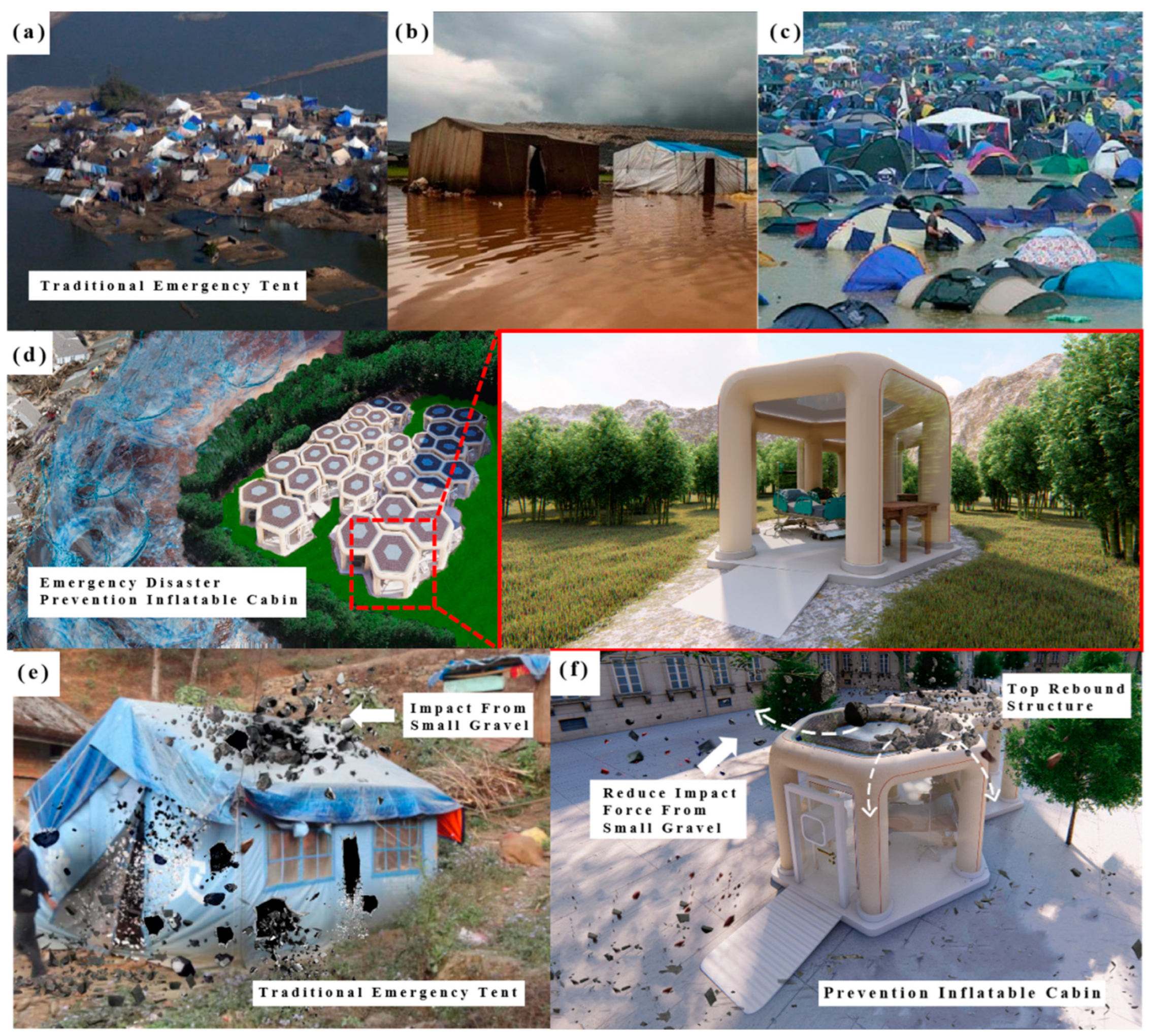
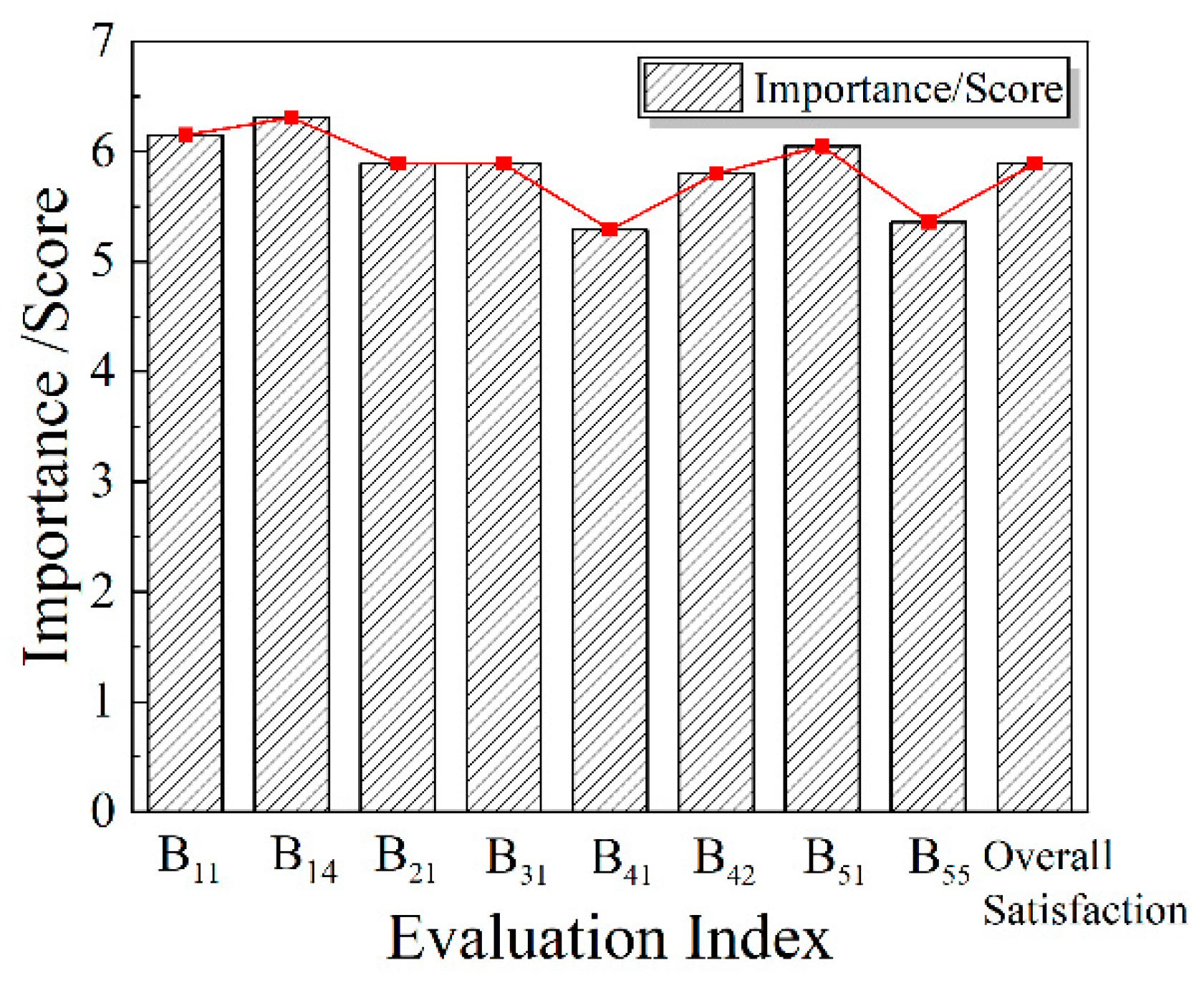
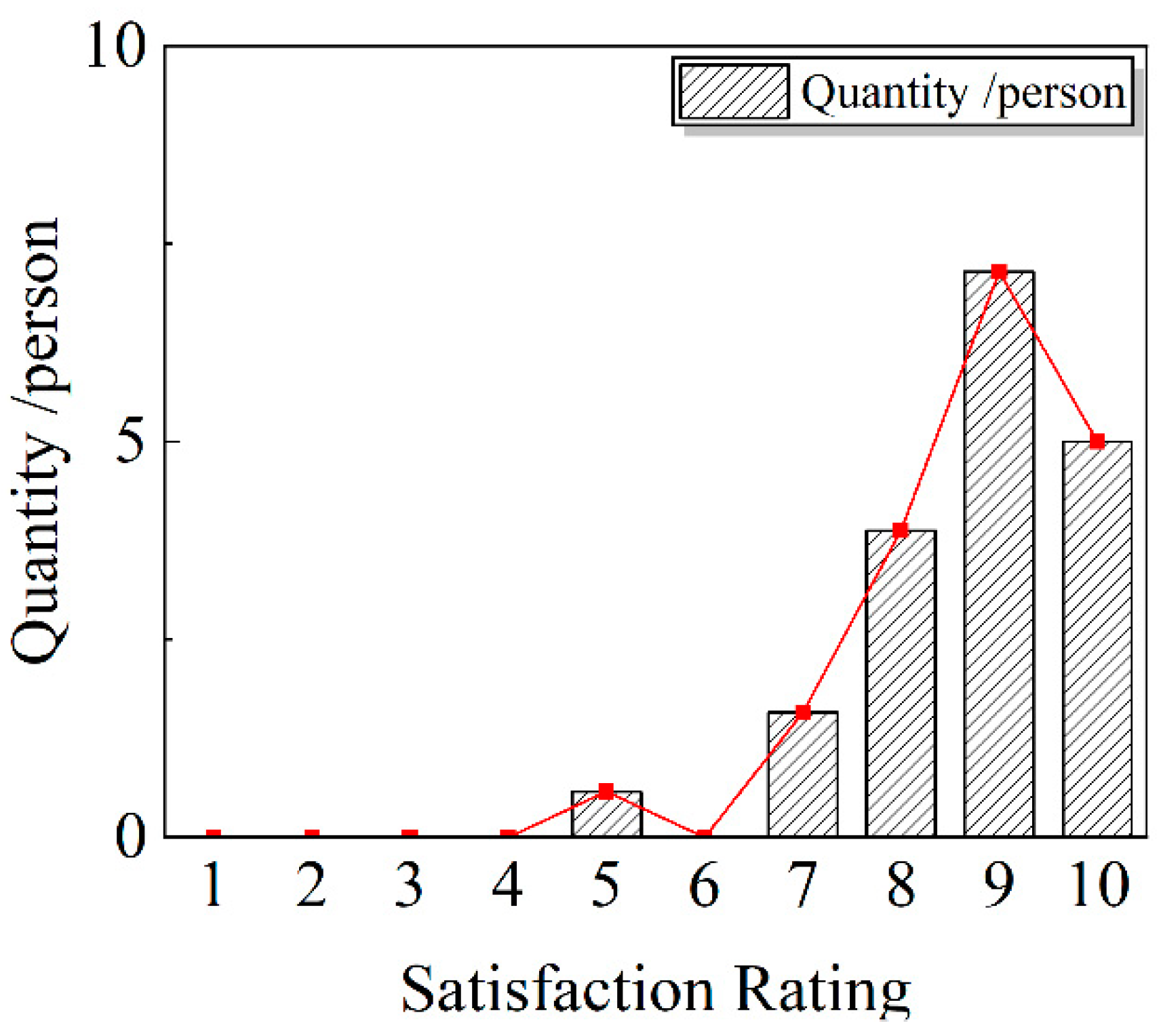
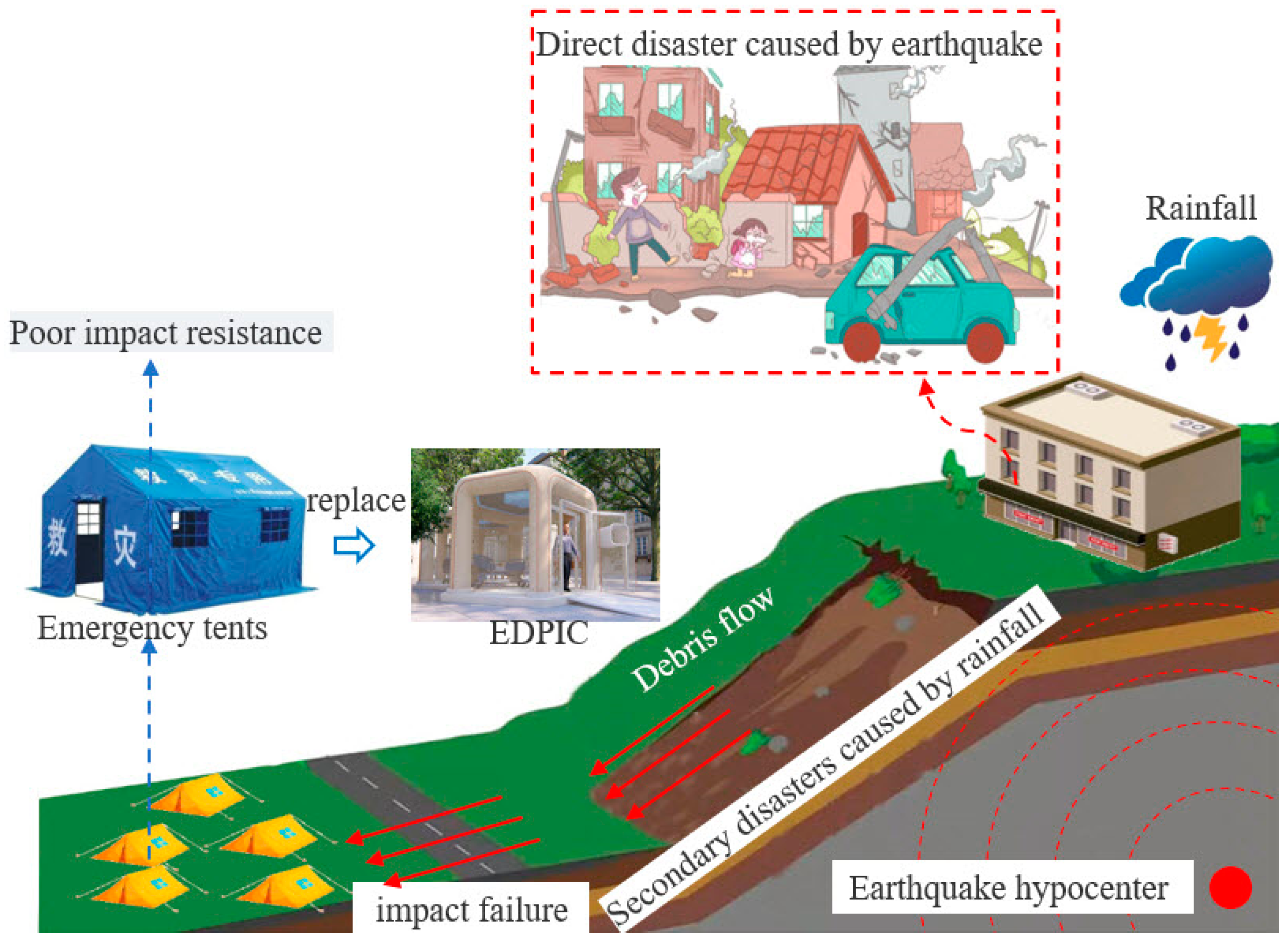

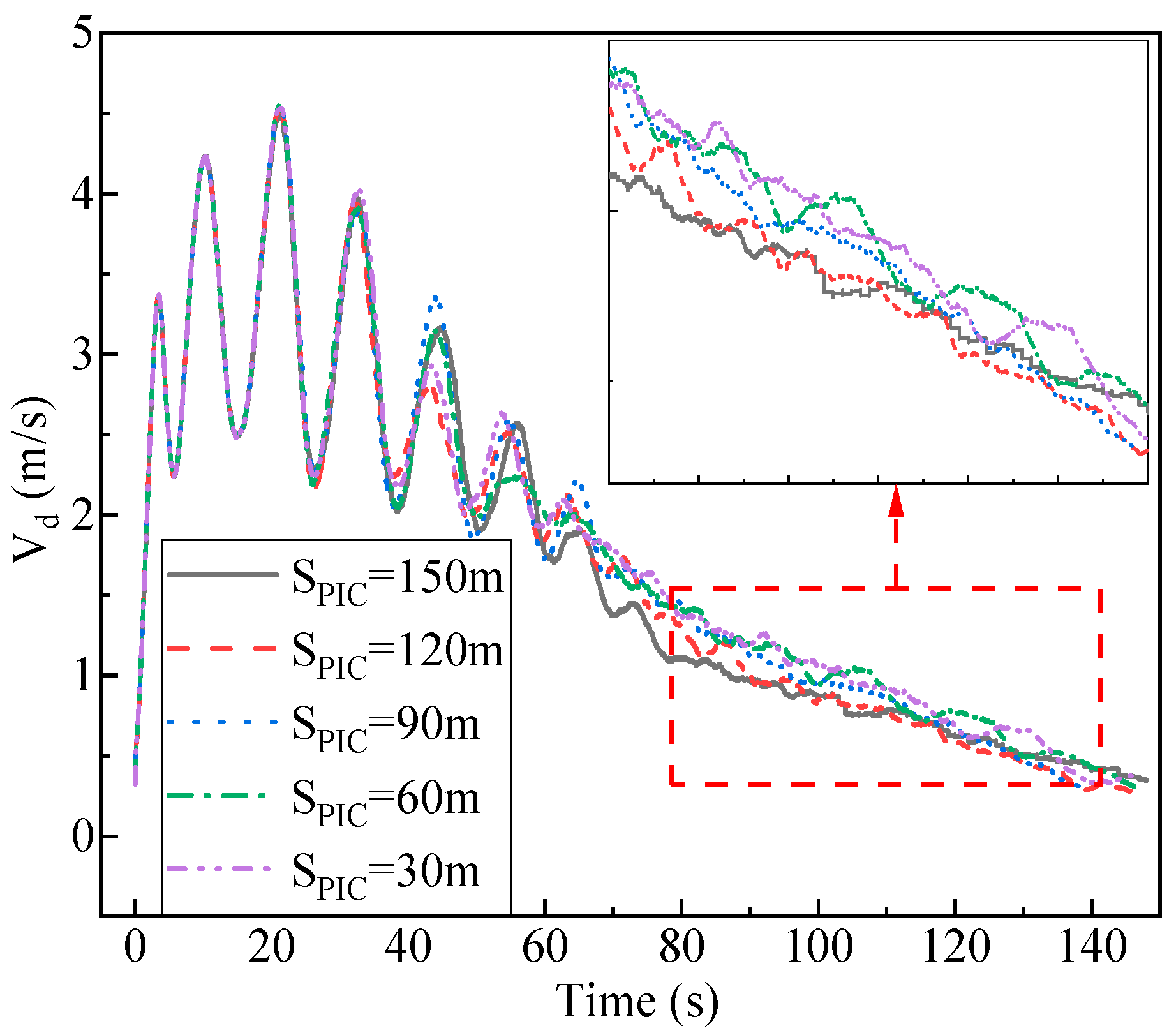
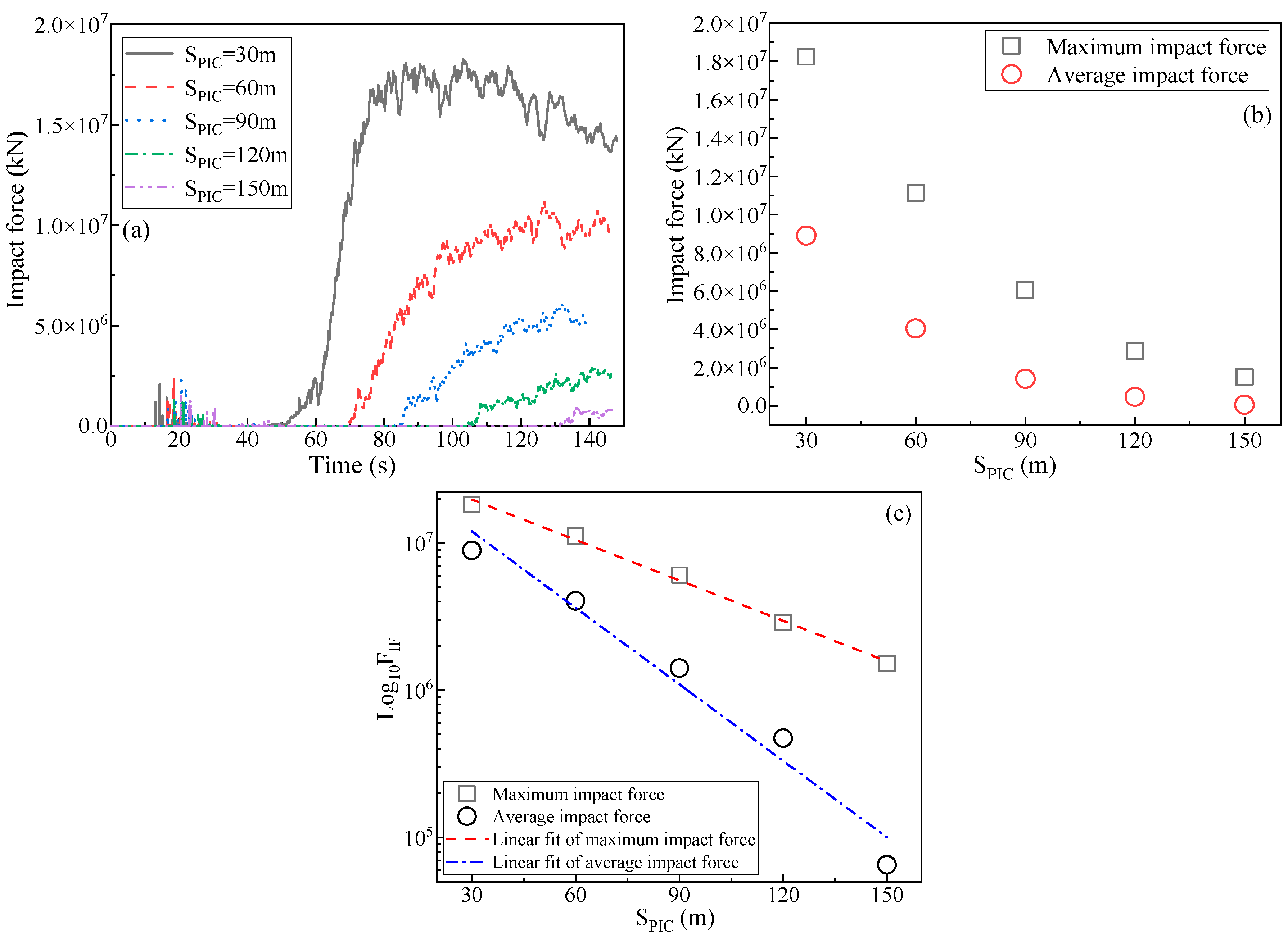

| Importance of post-disaster product design (U) | Tier 1 Indicator | Tier 2 Indicator | ||
| U1: Safety and comfort | U11: People-centered principle | U12: Structural stability | U13: Thermal insulation | |
| U2: Sustainability | U21: Modularization | U22: Life cycle assessment and optimization | U23: Use of renewable energy sources | |
| U3: Operational practicality | U31: Easy-to-use construction steps | U32: Ease of transportation and storage | U33: Adaptability to different environments | |
| U4: Aesthetic ornamental | U41: Honeycomb shape and aesthetic ornamental features | U42: Color and texture | U43: Visual harmony with surroundings | |
| U5: Flexibility and richness of form | U51: Inflatable membrane structure and foldable design | U52: Customizability | U53: Expandability and modularity | |
| Symbol | Secondary Indicator | Scoring Interval | Final Score for Level 1 Indicators |
|---|---|---|---|
| p1 | U11: People-centered principle | [90, 100] | P |
| p2 | U12: Structural stability | [80, 90] | |
| p3 | U13: Thermal insulation | [0, 80] | |
| w1 | U21: Modularization | [90, 100] | W |
| w2 | U22: Life cycle assessment and optimization | [80, 90] | |
| w3 | U23: Use of renewable energy sources | [0, 80] | |
| c1 | U31: Easy-to-use construction steps | [90, 100] | C |
| c2 | U32: Ease of transportation and storage | [80, 90] | |
| c3 | U33: Adaptability to different environments | [0, 80] | |
| m1 | U41: Honeycomb shape and aesthetic ornamental features | [90, 100] | M |
| m2 | U42: Color and texture | [80, 90] | |
| m3 | U43: Visual harmony with surroundings | [0, 80] | |
| n1 | U51: Inflatable membrane structure and foldable design | [90, 100] | N |
| n2 | U52: Customizability | [80, 90] | |
| n3 | U52: Expandability and modularity | [0, 80] |
| Parameters | Values |
|---|---|
| Gravitational acceleration, g (m/s2) | 9.81 |
| Particle density, ρ (kg/m3) | 2650 |
| Normal stiffness coefficient, Kn (N/m) | 105 |
| Tangential stiffness coefficient, Kt (N/m) | 105 |
| Interparticle friction coefficient, μ | 0.5 |
| Restitution coefficient, e | 0.5 |
| Volume fraction, Φ | 0.7 |
| Maximum Impact Force | Average Impact Force | |
|---|---|---|
| Equation | ||
| Intercept | 7.571 | 7.599 |
| Slope | −0.009 | −0.017 |
| COD | 0.995 | 0.968 |
| Research Level | Specific Performance in Disaster Prevention and Management | Feature |
|---|---|---|
| Macro | Measure and assess affected areas | Clarify the importance and scale of the disaster for disaster prevention and planning for recovery and development |
| Meso | Identify prioritized disaster prevention product design needs | Focus on human and environmental needs, meeting the needs of users, and better following the principles of sustainability in terms of materials, colors, and shapes |
| Micro | Measure the structural resistance of the product | Functionality is the core of disaster prevention products and is closely related to user safety |
| Macro–meso–micro | GIS-AHP mixed with numerical simulation analysis | More comprehensive and systemic |
Disclaimer/Publisher’s Note: The statements, opinions and data contained in all publications are solely those of the individual author(s) and contributor(s) and not of MDPI and/or the editor(s). MDPI and/or the editor(s) disclaim responsibility for any injury to people or property resulting from any ideas, methods, instructions or products referred to in the content. |
© 2024 by the authors. Licensee MDPI, Basel, Switzerland. This article is an open access article distributed under the terms and conditions of the Creative Commons Attribution (CC BY) license (https://creativecommons.org/licenses/by/4.0/).
Share and Cite
Wang, X.; Pan, Y.; Liu, Y. Research on Green Modular Disaster Prevention Product Design and Spatial Configuration Strategy Based on AHP-GIS. Designs 2024, 8, 89. https://doi.org/10.3390/designs8050089
Wang X, Pan Y, Liu Y. Research on Green Modular Disaster Prevention Product Design and Spatial Configuration Strategy Based on AHP-GIS. Designs. 2024; 8(5):89. https://doi.org/10.3390/designs8050089
Chicago/Turabian StyleWang, Xinyi, Yangyang Pan, and Yu Liu. 2024. "Research on Green Modular Disaster Prevention Product Design and Spatial Configuration Strategy Based on AHP-GIS" Designs 8, no. 5: 89. https://doi.org/10.3390/designs8050089
APA StyleWang, X., Pan, Y., & Liu, Y. (2024). Research on Green Modular Disaster Prevention Product Design and Spatial Configuration Strategy Based on AHP-GIS. Designs, 8(5), 89. https://doi.org/10.3390/designs8050089







